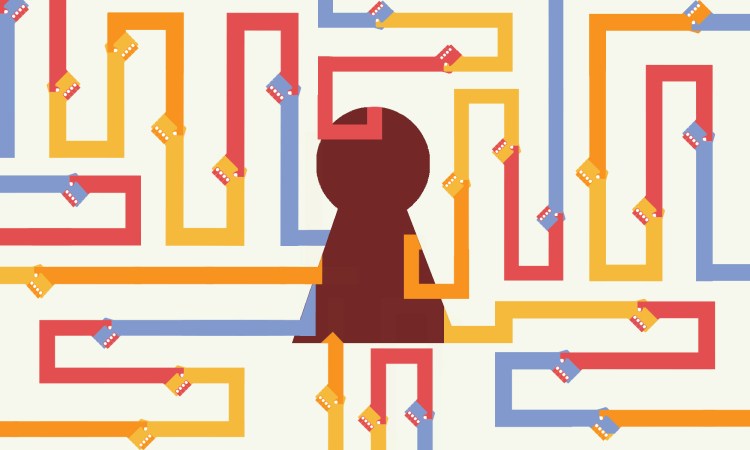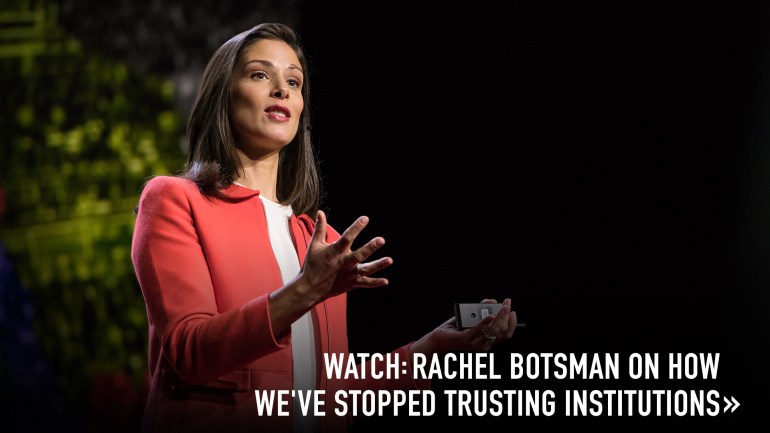
Once upon a time, you would have thought long and hard before you bought sneakers from a stranger in another country or rented out your home to one. So what made you feel it was safe, useful and okay? Trust researcher Rachel Botsman explains the process.
Try this quick experiment. The next time you are sitting next to someone you don’t know, ask them to swap phones with you for one minute. Explain that you will hold their phone and they can hold yours. Tell them: ‘What you decide to do with it is your choice.’
I have played this game many times with different groups of people, from financial advisors to students to real-estate agents (you can see Airbnb cofounder Joe Gebbia play this game with the TED audience here) . Some refuse. Others hesitantly take the phone but place it face down. A few launch into the experiment, looking at messages, photos and Twitter feeds. Some tweet or post on Instagram. But for the most part, it feels very uncomfortable for participants, even though it’s just about holding a phone for 60 seconds.
Given that discomfort, how have people been able to make the leap of trust and let strangers into our cars for shared rides (like the long-distance ride-sharing platform BlaBlaCar) or let them stay in our own homes (like home-rental marketplace Airbnb)? Over the past decade, I have researched hundreds of networks, marketplaces and systems that reinvent the way something of value — a product, service or information — reaches people. I’ve observed a common behavioral pattern people that follow in forming trust.
I call it “climbing the trust stack.” First, we have to trust the idea; then the company; and, finally, we have to trust the other person (or, in some instances, a machine or robot). It’s this last level where real trust happens, but we can’t get there without going through the other two stages.
Airbnb has had to create trust around an exchange that involves one of the most intimate things in our lives: the place where we rest our heads.
So what coaxes us into passing that first layer and trusting new ideas? There are some universal hurdles that need to be overcome first. The conditions that enable that to happen are summed up in three key notions: the California Roll principle, the WIIFM factor (“what’s in it for me”), and trust influencers.
The California Roll principle depends on making the unfamiliar more familiar. Consider sushi. When US restaurateurs attempted to popularize the Asian delicacy with Americans in the 1960s, at first the idea did not bite — to many non-Japanese eaters, the thought of consuming raw fish wrapped in seaweed was bewildering, even dangerous-sounding. What helped win them over? The introduction of the California roll, which had ingredients — cucumber, avocado, crab — that were already very familiar to people and well-liked. Demand exploded, and Americans now consume $2.25 billion worth of sushi annually.
Airbnb has had to create trust around an exchange that involves one of the most intimate things in our lives: the place where we rest our heads. “We have to enable Olympic levels of trust between people who have never met,” Airbnb director of research Judd Antin says. A lot of research has been done on how people “get” the concept behind it. There are no “How does Airbnb work?” videos on the homepage. Admittedly, some people look at the “About” or “Trust and Safety” pages, but they’re at the bottom of the page. Front and center, the first thing on Airbnb is an empty box that encourages you to type in a destination.
“One of the ways people get the concept is by relating to something they understand,” Antin says. “What we observe when new guests come to the site is that they don’t typically go to the educational materials … Instead, they go straight to the search box and they search for places in their hometown because it’s a place they know, right?’
For example, when a first-time guest living in London wants to stay in New York, they might not search for New York but for London instead. “They look at the map of results and the guest’s reaction is, ‘Oh, oh, I see. This is somebody whose house is just near mine, over there by the river, and you could stay there if you wanted to. Now I get it,’” Antin says. Airbnb has designed the site to encourage this behavior and to allow new users to discover something they can easily understand — that other nearby homes, like theirs, are available for rent.
We don’t want to use a new invention until we understand it. That doesn’t mean we need to understand how it functions, but we need to grasp what it can do and what it can give us.
Once we are over the “I get this” hump, the next barrier to be crossed is the “What’s in it for me?” (WIIFM) factor. American sociologist James Samuel Coleman was fascinated by the ways people decide whether or not to trust a new idea. Essentially, his research showed we decide whether to trust based on assessment of the upsides and downsides. We make a calculation about whether trusting an idea will make our lives better or not.
It sounds obvious. But it raises a critical point — we don’t want to use a new invention until we understand it. That doesn’t mean we need to understand how a technology functions, whether it was a television back then or a blockchain now. However, we need to grasp what it can do and what it can give us. Until that chasm is crossed, we won’t abandon what we have.
Creating trust in a TV is one thing. What about creating trust in something that has the power to hurt or even kill us? We’re seeing this play out now with self-driving
cars. Three out of four drivers in the US said they would feel “afraid” to ride in self-driving cars, according to a March 2016 survey conducted of its members by the American Automobile Association. Only one in five said they would trust a driverless vehicle to drive itself with them inside.
An expert who knows the issue firsthand is Dr. Brian Lathrop. Lathrop has worked in the Electronics Research Lab at Volkswagen (VW) since 2004. He has a PhD in cognitive psychology, specializing in human interface design, and is in charge of research and development of VW’s autonomous vehicles. When I ask him how hard it is to get people to trust being driven by autonomous vehicles, I assume he will go into details of how smart design can overcome fears. I expect him to cite the safety stats. In fact, he makes a quite different observation. “People trust the car quickly, almost too easily,” he says.
Yes, Lathrop has seen how some people freak out the first time they are driven by an autonomous car. They are, however, the minority. Others are awestruck and think, “Wow, it’s doing the driving for me.” But then something interesting happens. After a few miles, the experience feels normal, even boring. Being driven by an intelligent machine, it turns out, is just not that exciting. In fact, Lathrop is worried about people nodding off.
The ultimate success of self-driving cars — that it becomes normal to use one — doesn’t depend on engineering success. It doesn’t even depend on us understanding the technology. It depends on that second principle of getting people to trust an idea, the WIIFM factor. We want to know what we will gain.
The typical American commuter spends on average more than 52 minutes per day stuck in traffic. That adds up to more than 4 billion hours of wasted time in the US alone, time we could use in better ways. “People want to know what they will be able to do if they are freed from driving the car,” Lathrop tells me. They imagine being able to watch movies, talk on the phone, work and eat. “Look around you when you’re at the traffic lights, when cars are stopped. These behaviors are not new. I want to allow people to do what they are already doing but in a much safer manner,” he says.
What would persuade people to trust an unknown digital startup? Seeing unexpected users doing it, who’d make them think, “Hey, maybe this idea isn’t so risky after all.”
The third element needed to achieve trust is human. You’ve no doubt heard the term “early adopter.” It refers to an individual who uses a new product or technology before others do. Without a doubt, early adopters are critical to innovations taking off, but as a group they are not necessarily the most needed to get the laggards to climb the first layer of the trust stack. What’s needed are what I call “trust influencers.” These are groups of people who can disproportionately influence a significant change in the way we do something; they set new social norms.
There is a wonderful example of trust influencers relating to what is not a particularly exciting concept: transferring money overseas. TransferWise founder Taavet Hinrikus was born in Estonia when it was still part of the USSR. It was a tough environment to grow up in. “One really had to take charge and solve problems in creative ways to get anything done,” Hinrikus says.
In 2006, Hinrikus had to move from Estonia to London for work, but he was still earning euros that were paid into his Estonian bank account. Every fortnight, he had to transfer money to a UK account, to cover his rent, food and costs. An old friend, Kristo Käärmann, faced the same problem but in the opposite direction. He was working as a consultant at Deloitte and was being paid in pounds. He was transferring money back to Estonia to pay his mortgage. “I was losing five per cent of the money each time I moved it,” Käärmann says. It disappeared due to hidden fees and poor foreign exchange rates.
Hinrikus and Käärmann came up with a simple but clever idea. “We figured we could just ‘swap’ the money. I could just transfer money from my Estonia account into his Estonia account, and he could transfer money from his account in London to my account in London,” says Hinrikus. “Pretty quickly, we saved thousands by eliminating unfair rates and banking fees.” The friends realized they had hit on an opportunity. TransferWise, the company they founded 2011, is valued at more than $1.1 billion.
TransferWise is based on a peer‑to‑peer technology system that matches money flows. If I wanted to send 1,000 pounds from a bank in London to a bank in Paris, the system looks for someone else wanting to convert euros to pounds. Doing things this way means the process is faster, easier and cheaper than the transfer services we get from banks.
Which brings us back to the question of trust and changing behavior. The conventional way to transfer money from one country to another has been to use a bank, post office, or known brand such as Western Union. So what would persuade ordinary people to trust an unknown digital startup? Seeing unexpected users doing it — people who would make them think, “Hey, maybe this idea isn’t so risky after all.”
But just who would those trust influencers be? Hinrikus and his team realized they were neither fintech know‑it‑alls nor the people with the latest Apple Watch. Instead, they were users who wouldn’t be expected to take a risk. Namely retirees, like British people living in Spain who needed to get their pension transferred from pounds to euros. “For them, the fees they were being charged represented a big portion of their total, so they had a strong incentive to take the same leap of faith,” Hinrikus says. When other first-time users heard about pensioners giving TransferWise the thumbs‑up, it had enormous influence on shaping their decision to trust the idea.
These three ideas — the California Roll principle, the WIIFM factor and trust influencers — can also be seen as “What is it?”, “What do I gain?”, “Who else is doing it?”. They offer a way to see how an idea once dismissed as preposterous can turn into something strangely familiar. They explain how trust in new ideas spreads. Anyone who has ever built trust in a venture, a new product or an idea has had to go through that process, and it is powerful. It can turn an idea once dismissed as risky and even frightening — sharing a long ride with a stranger, staying in the home of someone you don’t know, or getting into a self- driving car — into something normal, rewarding and disruptive.
Excerpted from the new book Who Can You Trust? How Technology Brought Us Together and Why It Might Drive Us Apart by Rachel Botsman. Published by PublicAffairs, an imprint of Hachette Book Group. Copyright © 2017 Rachel Botsman.












